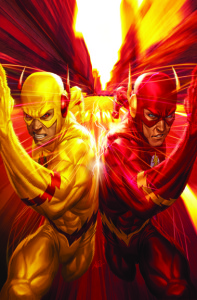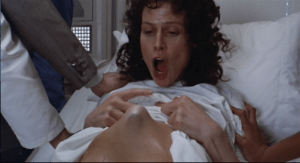Hello, fellow Geekademics. I’ve wanted to do another TTNtGA for awhile now, and I’ve had a few ideas, but none of them were quite enough for an entire article, so I’m pasting a few of my smaller ideas together into one bigger one. With luck, at least one of them will be interesting. Enjoy!
Hero/Villain Synthesis

This is one seen most often, but not exclusively, in superhero comics. The hero’s greatest foe is exactly like them, even down to the same power set, but with a differently-colored costume and evil. Sometimes it’s an evil twin, or another version of the hero from an alternate reality, or someone inspired by the hero who took something personally. There are lots of possibilities, but what it boils down to is a hero’s unique set of abilities is rendered nil (and usually such villains know all the hero’s tricks as well) and they must win through some sort of psychological advantage or outside force. Once in awhile, this can be a compelling idea, but when pretty much every single hero has at least one villain who is just them, or in some cases a whole lot of them (I’m looking at YOU, Geoff Johns and the Rainbow Lantern Corps…es!), it could logically be suggested that the idea is a bit stale, and may Need to Go Away.
Obviously, as writers we like to draw comparisons between our characters, particularly our heroes and villains, to make their interactions exciting and complex, and finding ways that people with vastly opposed ideals and moral systems are alike is often a fun logical puzzle. That said, always going for something exactly the same as one’s starting material is rather limiting, and plenty of ways to explore character are less obvious. I hate to use the most famous example here, but there’s a reason Batman and the Joker are such an iconic pairing. On the surface, it seems absurd. When I think of natural enemies, bat versus clown does not immediately spring to mind, but exploring the idea a bit deeper, it makes sense. Batman adapts the image of something terrifying to help people, while the Joker uses the image of something innocent and happy to cause destruction and chaos. This tells us exactly what we need to know about these two characters and how they interact, and they don’t need to be the same, or even similarly themed animals. Subtlety is the watchword for authors when it comes to symbolism. The less you beat your audience over the head with your ideas, the more they’ll appreciate figuring them out for themselves.
Dream Sequence Fakeouts

Dream sequences are a hallmark of fiction, and used well, they can be extremely effective storytelling devices. Dreams can move beyond the realm of the literal and explore a character’s thought process in a way even the characters themselves never could through action or dialogue, especially if they’re suppressing some part of themselves. Dreams are also cool because they can be poetic and strange, allowing storytellers to play with imagery more loosely and let their imaginations run wild. That said, there is one aspect of dream sequences that Needs to Go Away, and that is the fakeout.
A dream sequence fakeout is, for the most part, played straight. We as the audience are given no indicators that such sequences are dreams at all. The people behave like themselves, the world’s details are consistent, but then something terrible happens, something we as the audience know would never happen in a million years, and the character awakens in fright. So what’s the problem? Why does one sort of dream sequence work while another does not? While I have no doubt that dreams vary a great deal from person to person, and some may be more metaphorical, some more wild and random, and others quite close to literal, the purpose of these dream sequence fakeouts is not to explore the psychology of the characters in such a way. Their purpose is somewhat cynical, in fact. They create a false emotional high, one that draws the audience in based on images or story hooks that are particularly bold, but because such events are “just dreams,” they are freed from the consequences of such highs. Such dream sequences are nothing short of emotional manipulation. I suppose sometimes these sequences may be made for the purposes of advertising and drawing in crowds, but this doesn’t exactly make them better.
A story should have the courage of its convictions. If a creator cannot follow through with an idea, they shouldn’t use it. If they have an idea which is bold but would break the story too much, they should try to find another place or way to use it while preserving their story structure. A dream sequence is a perfectly valid means of telling a story, but using them pure gimmick cheapens both the story itself as well as the idea of dreams in fiction.
Intentional Letdowns

Not every moment in a story can be its best and highest, and trying too hard along these lines can cause a story to feel manipulative, or as though it’s trying too hard. Sometimes, plot elements can be resolved quickly, and serve less as a story’s high moments and more as resolution or study of character through action. If done well, such easy resolutions allow protagonists to be competent (such as the above image of Indy shooting the swordsman). However, if done poorly, it becomes an intentional letdown, something which, you guessed it, Needs to Go Away.
I call these intentional letdowns because quite often the creator is in on the joke, winking for the crowd and saying something akin to, “Hey, see how we did all that setup and nothing came of it? Eh? Just like in real life sometimes, am I right?” I am perhaps hamming it up a bit, but that is what’s going on. Such things can occasionally also be played for laughter, but if a plotline or character is played from the start as deadly serious and important, and we are told by the end that they were simply not a big deal, it’s easy to feel cheated and manipulated by the resolution. This is especially true if the main crux of the story is an intentional letdown after we’re told from the start how dire it was.
I suspect that some of the reason this happens is because people either don’t plan well beforehand and require an easy out before their deadlines come due, or because they overfilled their works with plot points and have to cut material to avoid being bloated. I’m sure there are some who do it intentionally, out of some sense of attempted realism, as well. It seems to me that in the former two cases, such problems can be avoided through more careful planning, but the latter is trickier. One could argue that it is simply a matter of taste or sensibilities, and as such, my disdain is my own problem. However, I think doing away quickly or dismissively with one’s own creations, especially after immense buildup, shows a lack of concern for one’s work. As creative people, we owe it to ourselves and our fans to care about what we create, and when we must perforce cut away such creations, we should do so with the utmost respect. A resolution can be triumphant, exhausting, incomplete, open to interpretation, depressing, hopeful, or just about anything else, but it should never be sloppy. There are those who argue that a story is the journey, not the destination, and while there is some truth to this, a journey is as meaningless without its destination as a destination is without its journey.
